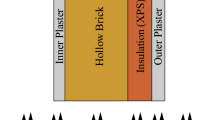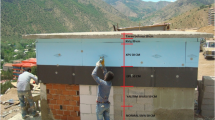Abstract
A significant portion of energy sources in many countries is devoted to the residential sector requirements. A considerable part of this energy is used for heating residential buildings. Minimizing the total heating cost of these buildings has a significant impact on reducing the economic burden and energy consumption. The deterministic parameters in the computation of total heating cost are the fuel type, insulation material and insulation thickness. Since these parameters are not linearly independent from each other, in the current study for a more comprehensive approach, a simultaneous multi-variable optimization model including both discrete and continuous design variables is developed. To solve the acquired model, the recently developed non-deterministic swarm-based approach so-called Interactive Search Algorithm is applied as the optimization method. The degree-day values dependent on the climatic conditions of seven different cities of Turkey are considered as case studies. Subsequently, achieved numeric outcomes are reported as the optimal total heating cost, fuel type (i.e., the sequential integer that indicates the type of fuel) and insulation layer’s material and thickness for each selected climate condition. Moreover, the resultant payback period and saving cost for the acquired optimal condition is calculated and announced. In all studied cities, a combination of natural gas for fuel type and glass wool for insulation material is obtained as the optimal state. The acquired optimal total heating cost values are consistent with the conventional approach results by an average deviation of 6.67e−3%, which reveals the proposed methodology works well in solving the problem.









Similar content being viewed by others
Abbreviations
- C :
-
Energy cost per unit surface ($/m2)
- E :
-
Energy need per unit surface (J/m2year)
- g :
-
Inflation rate (%)
- H u :
-
Lower heating value of the fuel (J/kg, J/m3)
- i :
-
Interest rate (%)
- k :
-
Thermal conductivity (W/mK)
- N :
-
Life time (year)
- Pp:
-
Payback period (year)
- q :
-
Heat loss per unit surface (W/m2)
- R :
-
Thermal resistance (m2K/W)
- S :
-
Saved energy for annual heating ($/m2year)
- T :
-
Temperature (K)
- U :
-
Total heat transfer coefficient (W/m2K)
- x :
-
Insulation thickness (m
- BEW:
-
Building external wall
- CGB:
-
Conventional gradient-based
- EPS:
-
Expanded polystyrene
- HDD:
-
Heating degree-day
- ISA:
-
Interactive search algorithm
- LPG:
-
Liquefied petroleum gas
- PWF:
-
Present worth factor
- SV:
-
Single-variable
- SMV:
-
Simultaneous multi-variable
- THC:
-
Total heating cost
- XPS:
-
Extruded polystyrene
- a:
-
Annual
- c:
-
Cement based
- f:
-
Fuel
- h:
-
Heating
- i:
-
Inside
- ins.:
-
Insulation
- L:
-
Lime based
- m:
-
Material of insulation
- o:
-
Outside
- opt:
-
Optimum
- t:
-
Total
- w:
-
Wall
- η :
-
Efficiency of the combustion system
References
Alsayed MF, Tayeh RA (2018) Life cycle cost analysis for determining optimal insulation thickness in Palestinian buildings. J Build Eng
Ashouri M, Astaraei FR, Ghasempour R, Ahmadi MH, Feidt M (2016) Optimum insulation thickness determination of a building wall using exergetic life cycle assessment. Appl Therm Eng 106:307–315
Batra U, Singhal S (2017) Optimum level of insulation for energy efficient envelope of office buildings. Int J Environ Sci Technol 14:2389–2398
Bergman TL, Lavine AS, Incropera FP, Dewitt DP (2011) Introduction to heat transfer. John Wiley & Sons, New Jersey
Bolattürk A (2006) Determination of optimum insulation thickness for building walls with respect to various fuels and climate zones in Turkey. Appl Therm Eng 26:1301–1309
Bolattürk A (2008) Optimum insulation thicknesses for building walls with respect to cooling and heating degree-hours in the warmest zone of Turkey. Build Environ 43:1055–1064
CBRT 2016. Records of the Central Bank of Republic of Turkey In: Central Bank of Republic of Turkey, C. B. T. C. (ed.). Turkey
Çomakl K, Yüksel B (2003) Optimum insulation thickness of external walls for energy saving. Appl Therm Eng 23:473–479
Cyrille Vincelas FF, Ghislain T (2017) The determination of the most economical combination between external wall and the optimum insulation material in Cameroonian’s buildings. J Build Eng 9:155–163
Daouas N (2011) A study on optimum insulation thickness in walls and energy savings in Tunisian buildings based on analytical calculation of cooling and heating transmission loads. Appl Energy 88:156–164
Dlimi M, Iken O, Agounoun R, Zoubir A, Kadiri I, Sbai K (2019) Energy performance and thickness optimization of hemp wool insulation and air cavity layers integrated in Moroccan building walls’. Sustain Prod Consum 20:273–288
Dombayci ÖA, Gölcü M, Pancar Y (2006) Optimization of insulation thickness for external walls using different energy-sources. Appl Energy 83:921–928
Dombayci ÖA, Atalay Ö, Güven Acar Ş, Yilmaz Ulu E, Kemal Ozturk H (2017) Thermoeconomic method for determination of optimum insulation thickness of external walls for the houses: case study for Turkey. Sustain Energy Technol Assess 22:1–8
Duffie JA, Beckman WA (1980) Solar process economics. Solar Eng Therm Process. Wiley, New York
Hasan A (1999) Optimizing insulation thickness for buildings using life cycle cost. Appl Energy 63:115–124
IGDC 2016. Fuel commercial properties. www.igdas.com.tr
Jie P, Zhang F, Fang Z, Wang H, Zhao Y (2018) Optimizing the insulation thickness of walls and roofs of existing buildings based on primary energy consumption, global cost and pollutant emissions. Energy 159:1132–1147
Kurekci NA (2016) Determination of optimum insulation thickness for building walls by using heating and cooling degree-day values of all Turkey’s provincial centers. Energy Build 118:197–213
Liu X, Chen Y, Ge H, Fazio P, Chen G, Guo X (2015) Determination of optimum insulation thickness for building walls with moisture transfer in hot summer and cold winter zone of China. Energy Build 109:361–368
MENR. 2017. Total energy consumption by sectors [Online]. Republic of Turkey Ministry of Energy and Natural Resources. Available: http://www.eigm.gov.tr/tr-TR/Denge-Tablolari/Denge-Tablolari [Accessed 13.12.2020 2020]
Mortazavi A, Toğan V (2016) Simultaneous size, shape, and topology optimization of truss structures using integrated particle swarm optimizer. Struct Multidiscip Optim 54:715–736
Mortazavi A, Toğan V, Nuhoglu A (2017) An integrated particle swarm optimizer for optimization of truss structures with discrete variables. Struct Eng Mech 61:12
Mortazavi A, Toğan V, Nuhoğlu A (2018) Interactive search algorithm: a new hybrid metaheuristic optimization algorithm. Eng Appl Artif Intell 71:275–292
Mortazavi A, Toğan V, Moloodpoor M (2019) Solution of structural and mathematical optimization problems using a new hybrid swarm intelligence optimization algorithm. Adv Eng Softw 127:106–123
Nematchoua MK, Raminosoa CRR, Mamiharijaona R, René T, Orosa JA, Elvis W, Meukam P (2015) Study of the economical and optimum thermal insulation thickness for buildings in a wet and hot tropical climate: case of Cameroon. Renew Sustain Energy Rev 50:1192–1202
Özkan DB, Onan C (2011) Optimization of insulation thickness for different glazing areas in buildings for various climatic regions in Turkey. Appl Energy 88:1331–1342
Rao RV, Savsani VJ, Vakharia DP (2011) Teaching–learning-based optimization: a novel method for constrained mechanical design optimization problems. Comput-Aided Des 43:303–315
Riggs JL, Bedworth DD, Randhawa SU (1996) Engineering economics. McGraw-Hill, New York
Rosti B, Omidvar A, Monghasemi N (2020) Optimal insulation thickness of common classic and modern exterior walls in different climate zones of Iran. J Build Eng 27:100954
Sasic Kalagasidis A (2004) HAM-tools—an integrated simulation tool for heat, air and moisture transfer analyses in building physics
Schoenau GJ, Kehrig RA (1990) Method for calculating degree-days to any base temperature. Energy Build 14:299–302
Selim G, Oliver K (2015) Prefab (and preserve): An investigation of retrofitting for Belfast’s Victorian terraced social housing. J Build Appr 4:66–77
Wati E, Meukam P, Nematchoua MK (2015) Influence of external shading on optimum insulation thickness of building walls in a tropical region. Appl Therm Eng 90:754–762
Acknowledgements
The authors wish to thank all who assisted in conducting this work.
Funding
No financial funds have been received.
Author information
Authors and Affiliations
Corresponding author
Ethics declarations
Conflict of interest
The authors declare that they have no conflict of interest.
Additional information
Editorial responsibility: Samareh Mirkia.
Rights and permissions
About this article
Cite this article
Moloodpoor, M., Mortazavi, A. Simultaneous optimization of fuel type and exterior walls insulation attributes for residential buildings using a swarm intelligence. Int. J. Environ. Sci. Technol. 19, 2809–2822 (2022). https://doi.org/10.1007/s13762-021-03323-0
Received:
Revised:
Accepted:
Published:
Issue Date:
DOI: https://doi.org/10.1007/s13762-021-03323-0




